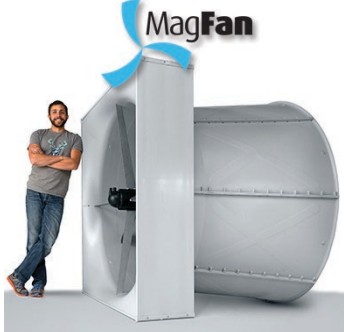
Available in other languages:
Content available at:
Español (Spanish)
The DACS Anti-Reverse device (pat. pending) is a 100% loss free and purely mechanical system, based on the principles of centrifugal and gravitational forces. It is designed as an add-on the the MagFan range of fans and is available for both the MagFan3 and MagFan5.

The Anti-Reverse system is available for the MagFan3 and MagFan5.
The system is integrated in the impeller hub and addresses a host of issues related to direct drive fans equipped with permanent magnet motors, commonly sold under trade names such as BLDC motors, EC motors or PM motors.
The permanent magnet motors have gained popularity over the last few years, in response primarily to higher energy costs but also due to their significantly longer service life. PM motors are typically used on direct drive fans.
By eliminating belts and pulleys, the PM motors offer benefits such as much higher energy efficiency and much reduced service costs.
The PM motors are synchronous machines, meaning they can’t operate as direct online motors. They must be controlled by some sort of speed controller, either a proper variable frequency drive (VFD) or the cheaper, often integrated, DC pulse controller.
Both controllers allow for variable speed operation. However, the DC pulse controller produces less torque and as a result the efficiency gains with such a controller are limited at low speed, and the pulse controller produces a lot of electromagnetic noise, making the VFD the much-preferred option from a technical point of view.
But regardless of the drive technology, there are challenges that need to be addressed when using permanent magnet motors in fans.
This power flows backwards, to the motor drive, and the power electronics in the drive must counteract that power.
In properly built VFDs the capacitors are sized to absorb the power, and the power electronics can brake, align, and start the fan motor even when it is spinning due to air pressure. It can be done but it requires a special setup and a lot of power – and then a portion of good luck.
In the cheaper systems with drives integrated in the motor (often referred to as BLDC or EC motors) the electronics are much more compact, and they simply can’t deal with the power influx from the motor. As a result, they fail and oftentimes the circuits burn.
Restarting a fan that is spinning in reverse requires a lot of power to counteract the mechanical force of the impeller. Most integrated electronics on BLDC/EC motors simply don’t have the power reserve and they can only restart if the fan impeller has been brought to a complete standstill.
But even the more advanced and robust VFDs have a power limitation and even litle power glimpses may cause significant downtime, putting the welfare and life of the livestock at risk.
The Anti-Reverse System from DACS effectively prevents any reverse rotation, eliminating the “windmilling” effect and protecting the power electronics.
In case of power failures, phase loss or other power supply anomalies, the Anti-Reverse system simply locks the fan impeller. When the power supply is restored, the fans start effortlessly and with a minimum of power input. With the Anti-Reverse system, soft starting procedures can be applied, and the current in-rush be reduced by a factor of 5 or more, depending on system setup.
At a speed of 160 rpm (set as minimum speed in the DACS VFD) the Anti-Reverse system disengages completely and as a result, the system is 100% loss free.
All DACS fans with the Anti-Reverse system have undergone extensive testing at Bess Lab, University of Illinois, and the Bess Lab test reports published all include the Anti-Reverse system.
For more information, contact Jens Dybdahl, DACS A/S: [email protected]
The Anti-Reverse system is on display at the DACS booth #B30043.
Subscribe now to the poultry technical magazine
AUTHORS

Layer Longevity Starts at Rearing
H&N Technical Team
The Strategy for a Proper Infectious Bronchitis Control
Ceva Technical Team
Elevate Hatchery Performance with Petersime’s New Data-Driven Incubation Support Service
Petersime Technical Team
Maize and Soybean Meal Demand and Supply Situation in Indian Poultry Industry
Ricky Thaper
Production of Formed Injected Smoked Chicken Ham
Leonardo Ortiz Escoto
Antimicrobial Resistance in the Poultry Food Chain and Novel Strategies of Bacterial Control
Edgar O. Oviedo-Rondón
GREG TYLER INTERVIEW
Greg Tyler
Insights from the Inaugural US-RSPE Framework Report
Elena Myhre
Newcastle Disease: Knowing the Virus Better to Make the Best Control Decisions. Part II
Eliana Icochea D’Arrigo
Avian Pathogenic E. coli (APEC): Serotypes and Virulence
Cecilia Rosario Cortés
The Importance of Staff Training on Animal Welfare Issues in Poultry Industry
M. Verónica Jiménez Grez
Rodent Control is a Key Factor in Poultry Biosecurity and Sustainability
Edgar O. Oviedo-Rondón